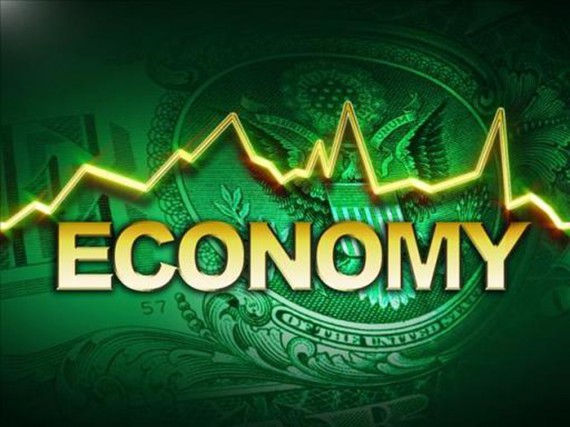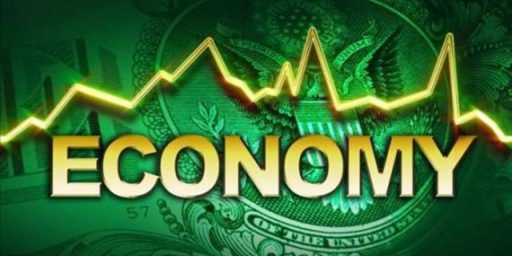Economic Growth In Final Quarter Of 2015 Pegged At Anemic 1.0%
Not exactly inspiring economic news from the Commerce Department.
The official estimate for economic growth during the last quarter of 2015 was revised slightly upward, and additional data released today suggests the first quarter may be healthier:
WASHINGTON — The U.S. economy got a double dose of good news Friday. Economic growth in the final three months of 2015 didn’t slow as much as previously estimated, and consumers roared back to life in January, spending at the fastest clip in eight months.
The Commerce Department said that consumer spending increased 0.5 percent last month, the best showing since May and far higher than the tiny 0.1 percent gain in December. Economists are expecting stronger consumer spending, which accounts for two-thirds of economic activity, to lift overall economic growth in the new year after a fourth-quarter slowdown.
In a separate report, the government said the gross domestic product, the broadest measure of economic health, grew at an annual rate of 1 percent in the fourth quarter. That’s an improvement from the first estimate of 0.7 percent, though just half the 2 percent growth posted in the third quarter.
The revision was made because the downturn in business stockpiling was less severe than the government’s first estimate. That helped offset slightly weaker consumer spending.
The Federal Reserve is closely watching economic data to determine how fast it needs to raise interest rates this year. The spending report showed that inflation, by a price measure preferred by the Fed, rose by 1.3 percent in the 12 months ending in January. That is nearly double the 0.7 percent 12-month gain seen in December but still below the Fed’s inflation target of 2 percent annual price increases.
Still, the inflation jump was sharp enough that it is sure to attract attention among Fed officials who are watching price increases for signals on how fast to raise interest rates. The Fed boosted a key rate by a quarter point in December, moving it from a record low near zero, where it had been for seven years.
After a stretch of economic turbulence at the beginning of the year, economists had trimmed their forecasts for 2016 rate hikes from four down to two. But if inflation accelerates more, that could encourage the Fed to move rates higher more quickly.
The latest GDP figure does little to change the fact that growth in the final months of 2015 was modest. Since then, global weakness and financial market turbulence have triggered worries about the potential fallout on the U.S. economy.
Still, economists are confident that GDP is poised to accelerate this quarter. Steady job gains and faster wage growth are boosting consumer spending, which accounts for more than two-thirds of the economy.
“First-quarter GDP growth is on track to rebound to a very healthy 2.5 percent (rate) which should dampen any concerns about an imminent recession,” said Paul Ashworth, chief U.S. economist at Capital Economics.
One factor that may help the state of the economy in the first three months of the year is the fact that, unlike both 2014 and 2015, the winter of 2016 has, so far at least, been relatively mild in the Midwest and Northeast, or at least far more mild than we saw in either of those two years when severe winter weather caused economic activity to grind to a halt to the extent that it actually turned negative in the first quarter of 2014 and barely grew in the first quarter of 2015. Nonetheless, the fact that the economy came out of 2015 in weak condition is somewhat concerning, especially since the final quarter of the year is typically one in which growth is stronger than at other points in the year due to increases in consumer spending associated with the holidays. Additionally, the fact that economic conditions elsewhere in the world continue to cause instability in financial markets. Even if that instability doesn’t lead to a recession here in the U.S., it has had a huge impact in several ways, including declining oil prices that have had a real impact on the energy sector of the economy.
As I’ve noted before, the importance of these statistics is now two-fold at this point. First of all, there’s the question of how all of this will impact Federal Reserve policy going forward and whether we’ll see additional interest rate increases this year. One percent economic growth in the final quarter of 2015 would seem to be an argument against raising rates even a small amount, but as noted above there are indications buried in the G.D.P. report that seem to suggest that inflation may be modestly increasing and that may cause the inflation hawks at the Fed to conclude that they need to continue raising rates to hold off a threat of inflation that doesn’t really seem to exist right now. Second, of course, is the fact that we’re in the opening stages of a Presidential election and that the state of the economy is likely to become a big issue going forward as it almost always is during such elections. If voters go into the voting booth in the fall feeling optimistic about the state of the economy, then this is likely to benefit the incumbent party even though President Obama isn’t on the ballot. If, on the other hand, voters feel uneasy about the state of the economy, or believe that the economy is not growing as strong as it needs to, which is essentially the root of the argument that most of the Republican candidates are making, then they may end up punishing the incumbent party holding the White House. Obviously, much of that will depend on statistics that won’t be released for months now but what is being released now will help to shape the narrative going forward.




There you go
The estimates for the last quarter of 2015 were optimistic too you know.
Though it may seem counterintuitive cheap oil may have a lot to do with it.
Not only the 200,000 plus layoffs but also the massive cuts in capital expenditures by producers over the past year.
The industry no longer see fracking as the panacea it once did.
Though it may seem counterintuitive cheap oil may have a lot to do with it.
Not only the 200,000 plus layoffs but also the massive cuts in capital expenditures by producers over the past year.
The industry no longer see fracking as the panacea it once did.
I wonder how much of this is related to the plunging prices of fossil fuels. Consulting firm Deloitte believes that one-third of US oil producers could go into bankruptcy this year. The major oil companies are laying of people in numbers that has not been seen in years and there is is virtually no upstream a acttivity. .
@Ron Beasley:
Upstream isn’t totally dead but it’s bad for sure.
Current US Rig Count 502 down 765 from this time last year. International count has fared better with a current count of 1045 down 213 from this time last year.
Analysts have identified $380 billion in capital expenditure cuts for exploration/production.
@Davebo: but everyone has an extra $1,000/yr. to spend due to lower prices- heard that logic on npr.
but the economy has been on life support way too long, this “low prime rate” bs i for the birds-time to get real and see if we really do suck.
Also there’s the wobble in the Chinese economy….
@Doug Mataconis: Well I’m confused then, because the article you’re quoting seems to say the opposite.
The revision was almost completely due to a smaller inventory reduction, and with inventory to sales ratios still high that simply means softness has been transferred to Q1,2 of this year. Manufacturing is in recession, and the durable goods report for January simply sucked. Consumer spending, the last best hope, was actually revised downward from 2.2% to 2. I also have to note that were we measuring GDP the same as we were just two years ago we would be reporting under water GDP. You can get any number you like when you play the game that way.
GDP anemia still seems to be the order of the day. Hence Trump and a Sanders appeal.
Very surprising because I expected low gas prices to have the same effect as a tax cut to bolster the economy and create an across the board consumer spending boost. Some markets such as auto sales are doing very well due to the low gas prices, giving consumers a huge incentive to spend. I’d love to see which segments of the economy are lagging, which are acting as a drag on the overall positives of a low gas price boost to the economy.
The signs point to an economic crisis or collapse in 2016.
http://www.cbsnews.com/news/global-growth-concerns-slowdown-us-economy/
The markets in Europe and China are falling. Look for the US to drop to 6,000.
Other factors: the currency problems and what is being considered. The Federal Reserve: set for more interest rates increase. Gold standard- being reconsidered ?
http://www.forbes.com/sites/nathanlewis/2016/02/25/the-one-chart-that-makes-people-into-gold-standard-believers/#78bf77a9e23c
http://beforeitsnews.com/economy/2015/04/the-us-dollar-will-no-longer-be-world-reserve-currency-as-economic-warfare-escalates-video-2714604.html
http://fortune.com/2016/01/23/china-collapse/
Rising health care costs put the health care program in trouble: sticker shock of double digit increases will force more to drop out. And this is just the beginning.
http://www.forbes.com/sites/robertharrow/2016/01/14/why-health-insurance-prices-will-continue-to-rise-in-2016-and-beyond/#6d651ea87291
Gas prices: the decline has certainly put more money into the people’s accounts. Most people are trying to pay off credit cards and other debts. Consumers can now use cash to buy food and other necessities instead of charging them.
Employment: not terrible, but not so good as the government would have us think. Many people have given up looking for work. Many others have returned to work at jobs that are far less than what they had.
http://www.gallup.com/opinion/chairman/181469/big-lie-unemployment.aspx
Is the economy changing into something far different from what we lived in from post-World War II to 2000 ? Is there a transformation that we are not seeing ? Think about the economy then: more nationalist, not much quality imports, huge work forces in offices and factories, physical labor important, and top down management styles. Also, it was “go to college, get a career”. The career word: that may be a thing of the past. People now need to prepare for multiple careers by having varied skills and flexibility.
Just my thoughts and observations.
Hmmm…Guarneri and Tyrell…or Buffet?
Who to listen to……….